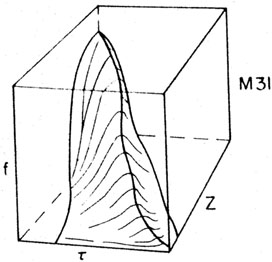Copyright © 1989 by Annual Reviews. All rights reserved
| Annu. Rev. Astron. Astrophys. 1989. 27:
139-59 Copyright © 1989 by Annual Reviews. All rights reserved |
5.1 M31
The oldest stars of M31 are detected in its abundant globular clusters (17, 28, 111) and in its halo RR Lyrae variables (101). Mould & Kristian (92) have detected halo giant stars, which are also presumably 15 Gyr old. There is, furthermore, the presumption that the central bulge of M31 [which makes up a large fraction of its luminosity (36)] also contains some old stars, judging from its colors (113) and from various kinds of spectrophotometry (96, 116), but no accurate measurement of the ages of the bulge stars is yet available. As a first approximation, these data indicate that M31 may have formed fractionally more stars in its initial period than did the MWG.
The old stars of the bulge of M31 do show a gradient in color (109, 113) and in spectral line intensities (18, 25), which may result from a range in mean age, in the mean abundances, or in the IMF. In any case, there is plenty of evidence that the bulge contains more than just old, metal-poor stars, as was once believed. This evidence includes the spectral synthesis studies cited above, as well as abundant evidence of young stars (from the UV excess) (32), gas (24, 78) and dust (49, 64, 115). Deharveng et al. (32) estimate the SFR in the bulge presently to be less than about 7 x 10-5 solar masses per year.
The M31 disk has been studied recently with increasingly better data. Since Baade's (14) pioneering work it has been known that the disk is rich in young stars. Attempts to reproduce its populations have been based on narrowband photometry (122) and on CMDs of variously located disk fields (16, 71, 72, 76, 87). These studies seem to indicate the presence of an old population, but they are unable to distinguish between a 2-Gyr-old population and a 15-Gyr-old one, for instance, and therefore there is uncertainty about the early history of the disk. On the other hand, these and other studies do show that there is considerable star formation going on at present in the disk. Spectra of individual stars (76) and the ratio of the number of carbon stars to M giants (102) both indicate that the chemical abundances in the disk are similar to those in the solar neighborhood.
All of these studies indicate that the populations of stars in M31 are similar to those in the MWG, but that there may be some minor but interesting differences. In particular, there may have been a longer or more intensive period of star formation in M31's earliest history, and there may now be a less vigorous mean rate of star formation than in the MWG. These tentative differences are shown schematically in Figure 10, when compared with Figure 9.

|
Figure 10. The population history of M31. |